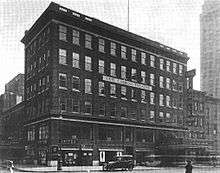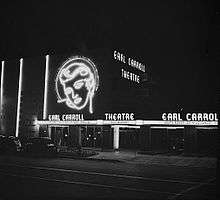Earl Carroll Theatre

Earl Carroll Theatre was the name of two important theaters owned by Broadway impresario and showman Earl Carroll. One was located in the Broadway Theater District in New York City and the other on Sunset Boulevard in Hollywood, California.
Broadway
The first was the Broadway theatre venture at 753 Seventh Avenue & West 50th Street in New York City. Designed by architect George Keister,[1] it opened in 1922[2] and was highly successful for a number of years until it was demolished and rebuilt on a lavish scale. It reopened in August 1931 with Carroll's billing that it was "the largest legitimate theater in the world." However, the facility's operating costs proved astronomical and it went into foreclosure in early 1932 after which it was acquired by producer Florenz Ziegfeld who renamed it the Casino Theatre. The Casino was the site of a very successful revival of Ziegfeld's production of Show Boat in 1932. However, Ziegfeld too went bankrupt only a short time later. After being acquired by Billy Rose and operating for a time as a night club, the theater closed in 1939. The building was converted to retail space in 1940 and eventually became a Woolworth's Department Store. It was demolished in 1990.
Sunset Boulevard
Earl Carroll built his second famous theater at 6230 Sunset Boulevard in Hollywood, California. It opened on December 26, 1938. As he had done at the New York theater, over the entrance Carroll emblazoned the words "Through these portals pass the most beautiful girls in the world". An "entertainment palace", the glamorous supper club-theater offered shows on a massive stage with a 60-foot (18 m) wide double revolving turntable and staircase and swings that could be lowered from the ceiling. The building's façade was adorned by what at the time was one of Hollywood's most famous landmarks: a 20-foot-high (6.1 m) neon head portrait of entertainer Beryl Wallace, one of Earl Carroll's "most beautiful girls in the world", who became his devoted companion. The sign survived several changes of ownership and venue name but was completely removed during major decorative overhauling in 1968. A re-creation made from photos is today on display at Universal CityWalk, at Universal City, as part of the collection of historic neon signs from the Museum of Neon Art. Another prominent exterior feature was the "Wall of Fame", on which were mounted more than a hundred individual concrete blocks autographed by Hollywood celebrities, including some of the biggest stars of the 1930s and 1940s.

Later achieving various degrees of fame in films and on television, Jean Spangler, Mara Corday, Yvonne De Carlo, Phyllis Coates, Maila Nurmi, Gloria Pall, and Mamie Van Doren were some of the showgirls who performed there. The facility was a popular night spot for many of Hollywood's most glamorous stars and powerful film industry moguls such as Darryl Zanuck and Walter Wanger, who sat on the Earl Carroll Theatre's board of governors.
The theater was sold following the 1948 deaths of Earl Carroll and Beryl Wallace in the crash of United Airlines Flight 624. It continued to operate but by the early 1950s it was falling on hard times.
Moulin Rouge
In 1953, Las Vegas showman Frank Sennes reopened the theater as a nightclub under the name "Moulin Rouge". The popular TV contest show Queen for a Day was broadcast from the Moulin Rouge during part of the show's 1956–1964 run.[3]
Hullabaloo
In late 1965 it became the "Hullabaloo", a minors-welcome rock and roll club, capitalizing on the popularity of the television variety show Hullabaloo.
Kaleidoscope
For several months in 1968 it was the "Kaleidoscope" and featured many top West Coast rock acts, with an emphasis on local bands such as The Doors.
Aquarius Theater
Later in 1968, the venue was redecorated in the psychedelic art style,[4] renamed the "Aquarius Theater", and rededicated as the home of a long-running Los Angeles production of the Broadway musical Hair. It was still sometimes used for rock concerts on Mondays, when the Hair company had its day off, and as a result the Aquarius is famous as the place where The Doors performed on July 21, 1969, making live recordings that were later issued commercially.[5]
In 1983, the Pick-Vanoff Company purchased the property and converted it into a state-of-the-art television theater that for nine years was the taping site of Star Search.[3] The Pick-Vanoff Company also owned Sunset-Gower Studios, formerly the home of Columbia Pictures. For many years, it was used for the annual Jerry Lewis MDA Telethon.[3] In the fall of 1993, the theater was the venue for Fox Network's The Chevy Chase Show under the name "The Chevy Chase Theater". The talk show was a disaster and was cancelled after five weeks; the theater reverted to its previous name soon after.[6]
Nickelodeon on Sunset
In the late 1990s, the name of the theater was changed to "Nickelodeon on Sunset" and it became the headquarters for Nickelodeon's West Coast live-action television production after the theater was acquired by the cable television channel Nickelodeon. Some of the shows filmed there for Nickelodeon include the ten-season run of All That, The Amanda Show, Drake & Josh, and more recently iCarly and Victorious.
In 2004, it was sold to a private equity firm as part of a larger parcel of property. As of September 2007, the City of Los Angeles Historic Preservation Board was working to assure that the theater is protected.
References
- ↑ "Earl Carroll Theatre, New York. George Keister, Architect" (April 1922). Architecture and Building. Vol. 54 No. 4, pp. 39-40
- ↑ "Just Because Opens" (March 23, 1922). The New York Times
- 1 2 3 Gordon, William A. (1992). The Ultimate Hollywood Tour Book. Toluca Lake, CA: North Ridge Books. p. 156. ISBN 0-937813-03-6.
- ↑ The psychedelic paint job was by the Dutch design collective The Fool, which also created iconic late-1960s graphics for The Beatles, Cream with Eric Clapton, Procol Harum and other patrons. Several photographs of the Aquarius Theatre murals may be seen here (accessed October 26, 2014).
- ↑ Alison Martino's "Vintage Los Angeles": The Aquarius Theater
- ↑ Entertainment Weekly article: "Err Time: Denise Richards is in good company -- look back at 10 major movie stars who flopped on TV".
Further reading
- Lost Broadway Theatres by Nicholas van Hoogstraten (1991). Princeton Architectural Press (ISBN 1-878271-06-7)
External links
 Media related to Earl Carroll Theatre (Broadway) at Wikimedia Commons
Media related to Earl Carroll Theatre (Broadway) at Wikimedia Commons
Coordinates: 34°05′51″N 118°19′29″W / 34.097488°N 118.324692°W